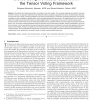Free Online Productivity Tools
i2Speak
i2Symbol
i2OCR
iTex2Img
iWeb2Print
iWeb2Shot
i2Type
iPdf2Split
iPdf2Merge
i2Bopomofo
i2Arabic
i2Style
i2Image
i2PDF
iLatex2Rtf
Sci2ools
ECCV
2004
Springer
2004
Springer
Stereo Using Monocular Cues within the Tensor Voting Framework
We address the fundamental problem of matching in two static images. The remaining challenges are related to occlusion and lack of texture. Our approach addresses these difficulties within a perceptual organization framework, considering both binocular and monocular cues. Initially, matching candidates for all pixels are generated by a combination of matching techniques. The matching candidates are then embedded in disparity space, where perceptual organization takes place in 3D neighborhoods and, thus, does not suffer from problems associated with scanline or image neighborhoods. The assumption is that correct matches produce salient, coherent surfaces, while wrong ones do not. Matching candidates that are consistent with the surfaces are kept and grouped into smooth layers. Thus, we achieve surface segmentation based on geometric and not photometric properties. Surface overextensions, which are due to occlusion, can be corrected by removing matches whose projections are not consisten...
Benchmark Stereo Pairs | Computer Vision | ECCV 2004 | Perceptual Organization Framework | Reliable Pixels | Tensor Voting Stage | Unmatched Pixels |
| Added | 15 Oct 2009 |
| Updated | 15 Oct 2009 |
| Type | Conference |
| Year | 2004 |
| Where | ECCV |
| Authors | Philippos Mordohai, Gérard G. Medioni |
Comments (0)

